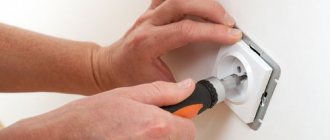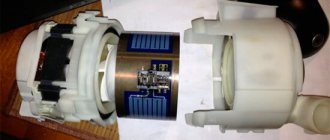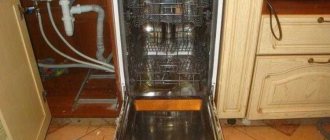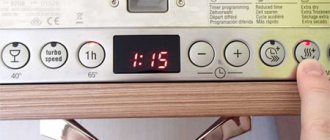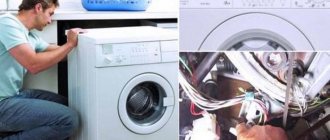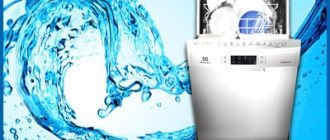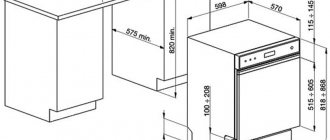Main causes of malfunction
What a shame it is when, having loaded a basket full of dirty dishes, you press the treasured “start” button, hoping to go drink coffee, but your faithful assistant refuses to work. Moreover, categorically!
What's the matter? The reason may turn out to be absurdly stupid, for example: for some reason one of your household pulled out the cord from the network... Or, having moved the machine a little while cleaning, he somehow stuck the same cord under it and it broke due to being crushed by a large weight technology.
It happens that the problem is not with the machine at all, but with a burnt-out socket to which it is connected.
If so, then everything is not so bad. In the first case, you just need to insert the plug into the socket, in the second, replace the cord, and in the third, reconnect the unit to another power source.
But there are even worse breakdowns and repairs are more expensive. If the first three reasons are not your case, still remain calm and only calm. You will always have time to call a specialist, but carrying out diagnostics yourself has never harmed anyone.
We present to you a list of the main reasons why the dishwasher does not start:
- The cord is broken in an inconspicuous place
- The door lock is faulty
- The "start" button is faulty
- Fuse burned out
- Water does not enter the chamber
- Broken program control unit
- Motor or relay burned out
- The pump is clogged
- Water supply hose squashed
In general, these are the main causes of breakdowns. Moreover, the third part of them is due to burnt fuses.
Now let's take a closer look at the signs of these popular malfunctions and perhaps you will be able to independently determine why the dishwasher does not start and the reasons for this.
See also -
Error codes for Bosch dishwashers
How does a dishwasher work?
To repair a dishwasher, you need to understand the processes that occur in it. This is the only way to determine the possible causes of the breakdown and eliminate them as soon as possible.
Let us describe the general principle of operation of a dishwasher. The operating algorithm is usually the same for all manufacturers, although some changes may occur. Next, we will describe the most time-consuming process - washing dirty dishes with time to “acidify” the remaining food.
- After loading the dishes, the door closes. This is recorded by a special sensor. If the lock is not closed, the dishwasher will not start.
- The user selects the dishwasher operating mode and presses the “Start” button.
Rinse water is supplied from all sides
- The water intake valve opens and it is pumped into a special tank. Along the way, it is mixed with softening salts and detergent. The water level is controlled by appropriate sensors.
- The tank contains heating elements - heating elements. They heat the water to the required temperature (depending on the selected mode). The degree of heating is controlled by a temperature sensor. The process continues only if the sensor is triggered.
- Heated water is supplied by a circulation pump to nozzles located on the side surfaces and sprayed in small portions. This is the "soak" mode.
- The liquid draining from the dishes is collected in a tray, passes through filters, and is again supplied to the nozzles.
- At the end of the time allotted for this mode (controlled by the processor), the rinsing mode is activated.
- In this mode, water is supplied from the main sprinkler, which is located under the basket with dishes. Powerful jets of water directed in different directions wash away any remaining dirt.
- The process goes on cyclically - the water is filtered, more detergent is added to it, and it again ends up in the sprinkler. This is how the final removal of contaminants occurs. The number of cycles depends on the selected program.
- After this mode ends (controlled by the processor), a command is given to drain the dirty water. The pump pumps it out of the reservoir.
- A small portion of water is pumped in to rinse the tank and removed again.
- Water is collected for rinsing. It is fed into a sprayer, which sprays it in different directions, washing the dishes from all sides. The rinsing process can be repeated several times.
- Waste water from the reservoir is pumped into the sewer system.
- Drying mode is activated. It all depends on the type of dishwasher. If there is a drying mode, heating elements are turned on to heat the air. Heated air is forced into the chamber using a fan. If there is no such mode, the dishwasher simply turns off - the dishes dry by convection.
Water is supplied from the nozzles under pressure
As you can see, a large number of sensors are involved in the process. All of them can fail and cause a breakdown. Filters, nozzles, and sprinklers may also become clogged. All these are causes of failure.
Read also: Soldering iron stand with power regulator
If the car doesn't turn on at all
In this case, only the following reasons are possible, from the general list above:
- The cord is broken
- Capacitor burned out
- The door lock is faulty
- The button is faulty
- The software block is faulty
- Motor or relay burned out
Start diagnostics in order, with the cord.
Cord
To do this, you need to arm yourself with a multimeter. We set it to ohmmeter mode and connect the probes to the sections of the wire of interest.
If you find that some part of the wire is burnt out, then you should not save money and change it by inserting a new piece. Any twists and solders are a fire hazard and unreliable. And this can subsequently lead to a fire or more serious damage inside the machine.
Fuse burned out
To diagnose the capacitor, you will need to disassemble the machine. We recommend covering the floor with a cloth first, as residual water may leak out of the unit.
The fuses are located in the circulation pump, under the pan. Therefore, you must disassemble it following this procedure:
- Remove the front panel located under the machine door
- Remove the side fastenings from the pallet
- Open the door, unscrew the debris filter and remove the impeller
- Close the door, turn the machine over and remove the tray
- Find the fuse on the circulation pump
- We check the resistance with a multimeter.
If it is discovered that the fuse is faulty, you need to find a completely identical one and replace it.
The door lock is faulty
This is the easiest to diagnose.
Either the door closes or it doesn’t. If not... There’s nothing you can do about it, of course... You can’t do it without calling a technician, and from a service center that has the required part. Of course, if you are very well versed in such breakdowns and know how and with what you can replace a broken door part, then you are in luck!
The start button is faulty
If you don't clearly see that the button looks strange, then it's unlikely that this is the problem. Most likely, in other electronics, that is, the control unit. But, if the button is stuck or loose, then it is the culprit. Look for the necessary spare part, change it or call a specialist.
The software block is faulty
This is perhaps one of the most disgusting and expensive breakdowns. The repair is quite expensive and there is no way you can do it on your own. The entire block will have to be replaced. But, do not rush to blame it prematurely until you have checked absolutely all possible options.
Motor or relay burned out
The machine will need to be disassembled and these parts checked for electrical conductivity with a multimeter.
If they burn out, things are bad... These are expensive parts, of course.
How to repair a dishwasher
In some cases, you can fix the problem yourself. Before starting work, disconnect the Ariston machine from the network and communications. Prepare the necessary tools.
Heater replacement
The heating element often suffers from scale when using hard water. If you hear an unpleasant burning smell, you need to check the wiring of the heating element, which may have burned out. Are you sure that the Hotpoint-Ariston heater is faulty? Then start replacing:
- Open the hatch door where the dishes are loaded.
- Remove all trays and shelves.
- Remove the water spray by pulling it up. It is located at the bottom of the car.
- At the bottom there is a filter that protects the pump from contamination. Unscrew the part and remove the mesh from below.
- Unscrew the bolts that secure the pipe and the heater.
- Place the dishwasher on its side with the bottom exposed.
- If the machine is freestanding, remove the rear panel by unscrewing the mounting bolts. If the device is built-in, remove the bottom.
- A pump is attached to the side of the heating element. You need to unscrew it clockwise. Disconnect the pump wiring and remove it from the housing.
- Disconnect the rubber fastener of the heater and remove the heating element.
Tip: To ensure proper wiring, take a photo of the connectors before removing the item from its socket.
Start the machine after repair to check the operation of the new element.
Checking the water intake valve and level sensor
When water does not flow into the Ariston dishwasher or, on the contrary, it constantly fills, check the intake valve. The part cannot be repaired, so you will need to disassemble the PMM:
- Remove the side or back panel (depending on model) of the dishwasher.
- The valve is located immediately behind the inlet hose.
- Unscrew the valve fasteners and disconnect the wiring.
- For replacement, a part is selected for a specific dishwasher model.
The pressure switch could also be broken. The reasons for its breakdown are natural wear, burnt contacts, and blockages in the pressure tube.
How to disassemble the car and get to the sensor:
- Open the bottom of the dishwasher.
- Find the level sensor. It looks like a box with pipes.
- Unscrew the two mounting bolts.
- Remove the tube from the box using pliers.
- Inspect the tank (box) for pressure.
- Check the electrical part of the pressure switch by measuring the resistance at the contacts.
- If damaged, install the new part in reverse order.
It’s easy to make the replacement yourself. Be careful and follow the recommendations.
Pump replacement
Below are instructions for replacing the dishwasher drain pump. The main thing in this repair is to properly disassemble the dishwasher.
- Open the machine's hopper door.
- Empty the hopper of shelves and baskets.
- Pull out the bottom filter, as well as the metal mesh.
- Unscrew the inlet hose.
- With the machine on its back, remove the bottom cover. To do this, unscrew the screws around the perimeter.
- Disconnect the wiring connectors from the pump.
- Use pliers to loosen the clamp on the drain hose. Disconnect it from the pump.
- Unscrew the fastening screw and remove the pump assembly.
- Reinstall the new pump with the rubber seal. Connect the wiring.
Please note that there is a circulation pump (motor) next to the drain pump. If the pump only drains water, then the pump drives it around the car, delivering it to the sprinklers.
If the Ariston PMM does not wash dishes, the reason may be the washing pump. We described above how to get to the drain pump. Then do this:
- First remove the drain pump.
- Disconnect the pump motor wiring.
- Release the engine mount.
- Unclench the metal hose clamps that are attached to the circulation pump (three hoses in total).
- Having pulled it out of the body, you need to remove the spring at the bottom and move it to a new part.
- Turn the spring clockwise and remove.
- To install a new motor (wash pump), you need to remove the old hose clamps and install new ones.
- Fasten the device in the reverse order.
